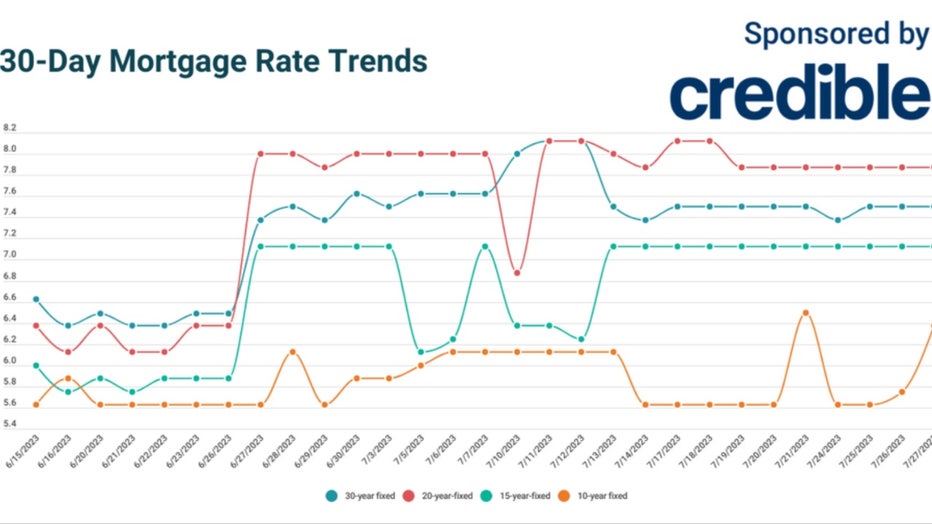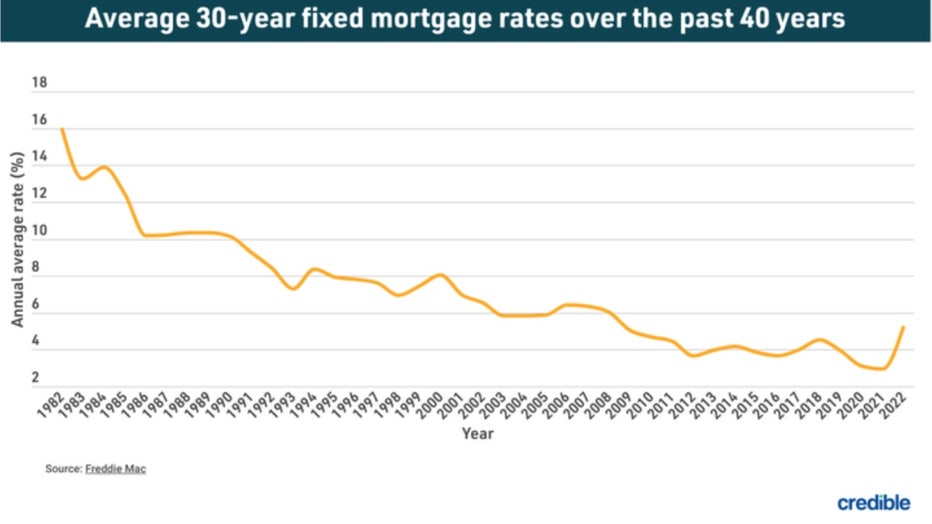Looking to save with today’s mortgage rates? Try shorter terms | July 27, 2023
Our goal here at Credible Operations, Inc., NMLS Number 1681276, referred to as "Credible" below, is to give you the tools and confidence you need to improve your finances. Although we do promote products from our partner lenders, all opinions are our own.

Check out the mortgage purchase rates for July 27, 2023, which are largely unchanged from yesterday. (Credible)
Based on data compiled by Credible, mortgage rates for home purchases have remained unchanged across three key terms, while another has risen since yesterday.
- 30-year fixed mortgage rates: 7.500%, unchanged
- 20-year fixed mortgage rates: 7.875%, unchanged
- 15-year fixed mortgage rates: 7.125%, unchanged
- 10-year fixed mortgage rates: 6.375%, up from 5.750%, +0.625
Rates last updated on July 27, 2023. These rates are based on the assumptions shown here. Actual rates may vary. Credible, a personal finance marketplace, has 5,000 Trustpilot reviews with an average star rating of 4.7 (out of a possible 5.0).
What this means: Mortgage purchase rates for 10-year terms have broken their three-day streak of staying within the 5% range after surging by over a half of a percentage point to 6.375%. Meanwhile, 15-, 20-, and 30-year terms continue to remain unchanged. Rates for 20-year terms have remained the highest at 7.875%. Additionally, rates for 15- and 30-year terms have remained at 7.125% and 7.5%, respectively. Borrowers interested in saving the most on interest rates should consider today’s lowest term, 10-year terms at 6.375%. Homebuyers who would rather have a smaller monthly payment should instead consider 30-year terms, as they have the lowest rate out of the two longer terms.
To find great mortgage rates, start by using Credible’s secured website, which can show you current mortgage rates from multiple lenders without affecting your credit score. You can also use Credible’s mortgage calculator to estimate your monthly mortgage payments.
Based on data compiled by Credible, mortgage refinance rates have fallen across all key terms since yesterday.
- 30-year fixed-rate refinance: 6.625%, down from 6.875%, -0.250
- 20-year fixed-rate refinance: 6.500%, down from 6.625%, -0.125
- 15-year fixed-rate refinance: 6.000%, down from 6.125%, -0.125
- 10-year fixed-rate refinance: 6.125%, down from 6.250%, -0.125
Rates last updated on July 27, 2023. These rates are based on the assumptions shown here. Actual rates may vary. With 5,000 reviews, Credible maintains an "excellent" Trustpilot score.
What this means: Mortgage refinance rates continue to stay in the 6% range for the third day in a row. Rates for 30-year terms saw the biggest drop today, falling by a quarter of a percentage point to 6.625%. Meanwhile, rates for 15-year terms have edged down to today’s lowest rate, 6%. Additionally, rates for 10- and 20-year terms have slightly decreased down to 6.125% and 6.5%, respectively. Homeowners looking to refinance into a lower monthly payment should consider 20-year terms, as their rates are lower than those of 30-year terms. Borrowers who would rather maximize their interest savings should instead consider 15-year terms.
How mortgage rates have changed over time
Today’s mortgage interest rates are well below the highest annual average rate recorded by Freddie Mac — 16.63% in 1981. A year before the COVID-19 pandemic upended economies across the world, the average interest rate for a 30-year fixed-rate mortgage for 2019 was 3.94%. The average rate for 2021 was 2.96%, the lowest annual average in 30 years.
The historic drop in interest rates means homeowners who have mortgages from 2019 and older could potentially realize significant interest savings by refinancing with one of today’s lower interest rates. When considering a mortgage or refinance, it’s important to take into account closing costs such as appraisal, application, origination and attorney’s fees. These factors, in addition to the interest rate and loan amount, all contribute to the cost of a mortgage.

How Credible mortgage rates are calculated
Changing economic conditions, central bank policy decisions, investor sentiment and other factors influence the movement of mortgage rates. Credible average mortgage rates and mortgage refinance rates reported in this article are calculated based on information provided by partner lenders who pay compensation to Credible.
The rates assume a borrower has a 700 credit score and is borrowing a conventional loan for a single-family home that will be their primary residence. The rates also assume no (or very low) discount points and a down payment of 20%.
Credible mortgage rates reported here will only give you an idea of current average rates. The rate you actually receive can vary based on a number of factors.
Why do mortgage rates fluctuate?
Here are some of the most common reasons why mortgage rates move frequently:
Employment patterns
The employment rate is an indicator of demand for mortgages. When more people are unemployed, fewer people will be looking to get a mortgage and buy a home — and that lower demand will push interest rates down. When the employment rate improves, demand for mortgages will likely keep pace. And as demand for mortgages rises, so will mortgage interest rates.
The bond market
Because bonds are a lower-risk type of investment, demand for bonds can increase when investors are wary of other investment vehicles, or fearful of the overall state of the economy. Increased demand for bonds causes their price to rise and their earnings — called their yield — to fall.
When bond yields fall, consumer interest rates generally do as well, including mortgage interest rates. When investors feel more confident about the economy, demand for bonds declines, bond prices drop, and yields rise. And interest rates tend to follow.
Federal Reserve System
"The Fed," as it’s commonly called, is the United States’ central bank. But it doesn’t actually set mortgage rates. Rather, multiple things the Fed does influence mortgage rates. For example, while mortgage rates don’t mirror the Fed funds rate — the rate banks apply when lending money to each other overnight — they do tend to follow it. If that rate rises, mortgage rates typically rise in tandem.
Global economy
Global banking systems and economies are closely interconnected. When economies in other parts of the world — especially Europe and Asia — experience a downturn, it affects investors and financial institutions in the United States. And, when foreign economies are doing well, they may attract more American investors — and divert those investment dollars out of the U.S. economy.
If you’re trying to find the right mortgage rate, consider using Credible. You can use Credible's free online tool to easily compare multiple lenders and see prequalified rates in just a few minutes.
Have a finance-related question, but don't know who to ask? Email The Credible Money Expert at moneyexpert@credible.com and your question might be answered by Credible in our Money Expert column.

